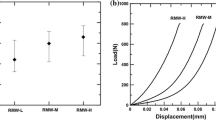Abstract
The friction-induced vibration triggered at the sliding interface between the gray iron disk and brake friction material was studied by changing the size of the zircon particles in the friction material. The friction tests were performed using a reduced brake dynamometer and the friction characteristics of the friction materials containing zircon particles with sizes of 3, 50, and 100 μm were analyzed. Our results show that the properties of the sliding surface were strongly affected by the entrenchment of the abrasive particles in the friction layers during sliding. The friction effectiveness was inversely proportional to the size of the abrasive, while friction instability was pronounced when smaller zircon particles were used. The smaller zircon particles produced larger plateaus on the sliding surface with low contact stiffness. However, the contact plateaus with the low contact stiffness showed higher amplitudes of the friction oscillations, suggesting a surface with low stiffness also can produce high propensity of friction instability during sliding. Based on the friction stability diagram and surface properties, such as contact stiffness and surface roughness, it was suggested that the static coefficient of friction, which was changed as a function of dwell time, was crucial to understand the cause of friction-induced force oscillations and propensity of friction instability of brake friction materials.












Similar content being viewed by others
References
Chen, F., Tan, C.A., Quaglia, R.L.: Disc Brake Squeal. SAE International, Warrendale (2006)
Duffour, P.: Noise Generation in Vehicle Brakes. Ph.D. thesis, Cambridge University (2002)
Crolla, D.A., Lang, A.M.: Brake Noise and Vibration—The State of the Art, pp. 165–174. Vehicle Tribology, Tribology Series (1991)
Lang, A.M.: An Investigation into Heavy Vehicle Drum Brake Squeal. Ph.D Thesis, Loughborough University (1994)
Eriksson, M., Bergman, F., Jacobson, S.: On the nature of tribological contact in automotive brakes. Wear 252, 26–36 (2002)
Sherif, H.A.: Investigation on effect of surface topography of pad/disc assembly on squeal generation. Wear 257, 687–695 (2004)
Lee, S.M., Shin, M.W., Lee, W.K., Jang, H.: The correlation between contact stiffness and stick–slip of brake friction materials. Wear 302, 1414–1420 (2013)
Jang, H., Kim, S.J.: Brake friction materials. In: Sinha, S.K., Briscoe, B.J. (eds.) Polymer Tribology, pp. 506–532. Imperial College, London (2009)
Cho, M.H., Kim, S.J., Basch, R.H., Fash, J.W., Jang, H.: Tribological study of gray cast iron with automotive brake linings: the effect of rotor microstructure. Tribol. Int. 36, 537–545 (2003)
Nicholson, G.: Facts About Friction. Gedoran America, Winchester (1995)
Cho, K.H., Jang, H., Hong, Y.S., Kim, S.J., Basch, R.H., Fash, J.W.: The size effect of zircon particles on the friction characteristics of brake lining materials. Wear 264, 291–297 (2008)
Kim, S.S., Hwang, H.J., Shin, M.W., Jang, H.: Friction and vibration of automotive brake pads containing different abrasive particles. Wear 271, 1194–1202 (2011)
Jang, H., Kim, S.J.: The effects of antimony trisulfide (Sb2S3) and zirconium silicate (ZrSiO4) in the automotive brake friction materials on friction characteristics. Wear 239, 229–236 (2000)
Lee, E.J., Hwang, H.J., Lee, W.G., Cho, K.H., Jang, H.: Morphology and toughness of abrasive particles and their effects on the friction and wear of friction materials: a case study with zircon and quartz. Tribol. Lett. 37, 637–644 (2010)
Ma, Y., Martynková, G.S., Valášková, M., Matějka, V., Lu, Y.: Effects of ZrSiO4 in non-metallic brake friction materials on friction performance. Tribol. Int. 41, 166–167 (2008)
Matějka, V., Lu, Y., Jiao, L., Huang, L.: Simha Martynková, G., Tomášek, V.: Effects of silicon carbide particle sizes on friction-wear properties of friction composites designed for car brake lining applications. Tribol. Int. 43, 144–151 (2010)
Rabinowicz, E.: The intrinsic variables affecting the stick-slip process. Proc. Phys. Soc. 71(4), 668–675 (1958)
Gao, C., Kuhlmann-Willsdorf, D., Makel, D.D.: The dynamic analysis of stick–slip motion. Wear 173, 1–12 (1994)
Persson, B.N.J.: Sliding friction: Physical Principles and Applications. Springer, Berlin (2000)
Fuadi, Z., Maegawa, S., Nakano, K., Adachi, K.: Map of low-frequency stick–slip of a creep groan. Proc. Inst. Mech. Eng. Part J: J. Eng. Tribol. 224, 1235–1246 (2010)
Kim, S.H., Jang, H.: Friction and vibration of brake friction materials reinforced with chopped glass fibers. Tribol. Lett. 52, 341–349 (2013)
Park, C.W., Shin, M.W., Jang, H.: Friction-induced stick–slip intensified by corrosion of gray iron brake disc. Wear 309, 89–95 (2014)
Nishizawa, Y., Kosaka, K., Kurita, Y., Oura, Y.: Influence of pad thickness and surface roughness on pad stiffness. SAE paper 2012-01-1817 (2012)
Lee, S.M., Shin, M.W., Jang, H.: Friction-induced intermittent motion affected by surface roughness of brake friction materials. Wear 308, 29–34 (2013)
Lee, W.K., Jang, H.: Moisture effect on velocity dependence of sliding friction in brake friction materials. Wear 306, 17–21 (2013)
Acknowledgments
This study was supported by the Ministry of Knowledge Economy (MKE) through the Parts and Materials Development Program (No. 10040819).
Author information
Authors and Affiliations
Corresponding author
Rights and permissions
About this article
Cite this article
Shin, M.W., Kim, Y.H. & Jang, H. Effect of the Abrasive Size on the Friction Effectiveness and Instability of Brake Friction Materials: A Case Study with Zircon. Tribol Lett 55, 371–379 (2014). https://doi.org/10.1007/s11249-014-0361-9
Received:
Accepted:
Published:
Issue Date:
DOI: https://doi.org/10.1007/s11249-014-0361-9




